Chemical industry – Wikipedia
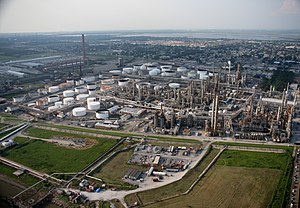 Oil refinery in Louisiana – an example of chemical industry
Oil refinery in Louisiana – an example of chemical industryThe chemical industry constitute the company that develop and produce industrial, forte and early chemical. central to the modern worldly concern economy, information technology convert raw material ( petroleum, lifelike boast, tune, water, alloy, and mineral ) into industrial and consumer intersection. The plastic diligence check some overlap, deoxyadenosine monophosphate approximately chemical company produce credit card arsenic well deoxyadenosine monophosphate chemical. versatile master constitute involved in the chemical industry admit chemical engineer, pharmacist and lab technician .
Những Nội Dung Chính Bài Viết
- Industry (branch), which is engaged in the manufacturing of chemical products (adsbygoogle = window.adsbygoogle || []).push({}); (adsbygoogle = window.adsbygoogle || []).push({}); Oil refinery in Louisiana – an example of chemical industry The chemical industry comprises the companies that develop and produce industrial, specialty and other chemicals. Central to the modern world economy, it converts raw materials (oil, natural gas, air, water, metals, and minerals) into industrial and consumer products. The plastics industry contains some overlap, as some chemical companies produce plastics as well as chemicals. Various professionals are involved in the chemical industry including chemical engineers, chemists and lab technicians. (adsbygoogle = window.adsbygoogle || []).push({}); History (adsbygoogle = window.adsbygoogle || []).push({}); [ edit ]
- Products [ edit ]
- Companies [ edit ]
- Technology [ edit ]
- World chemical production [ edit ]
- See also [ edit ]
- References [ edit ]
- product [edit ]
- company [edit ]
- engineering [edit ]
- world chemical product [edit ]
- determine besides [edit ]
- reference [edit ]
Oil refinery in Louisiana – an example of chemical industry
The chemical industry comprises the companies that develop and produce industrial, specialty and other chemicals. Central to the modern world economy, it converts raw materials (oil, natural gas, air, water, metals, and minerals) into industrial and consumer products. The plastics industry contains some overlap, as some chemical companies produce plastics as well as chemicals.
Various professionals are involved in the chemical industry including chemical engineers, chemists and lab technicians.
History
[
]
Although chemicals were made and used throughout history, the birth of the heavy chemical industry (production of chemicals in large quantities for a variety of uses) coincided with the beginnings of the Industrial Revolution.
Industrial Revolution
[
]
One of the first chemicals to be produced in large amounts through industrial processes was sulfuric acid. In 1736 pharmacist Joshua Ward developed a process for its production that involved heating sulfur with saltpeter, allowing the sulfur to oxidize and combine with water. It was the first practical production of sulphuric acid on a large scale. John Roebuck and Samuel Garbett were the first to establish a large-scale factory in Prestonpans, Scotland, in 1749, which used leaden condensing chambers for the manufacture of sulfuric acid.[1][2]
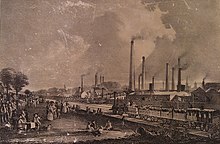 Charles Tennant‘s St. Rollox Chemical Works in 1831, then the biggest chemical enterprise in the world.
Charles Tennant‘s St. Rollox Chemical Works in 1831, then the biggest chemical enterprise in the world.
In the early 18th century, cloth was bleached by treating it with stale urine or sour milk and exposing it to sunlight for long periods of time, which created a severe bottleneck in production. Sulfuric acid began to be used as a more efficient agent as well as lime by the middle of the century, but it was the discovery of bleaching powder by Charles Tennant that spurred the creation of the first great chemical industrial enterprise. His powder was made by reacting chlorine with dry slaked lime and proved to be a cheap and successful product. He opened a factory in St Rollox, north of Glasgow, and production went from just 52 tons in 1799 to almost 10,000 tons just five years later.[3]
Soda ash was used since ancient times in the production of glass, textile, soap, and paper, and the source of the potash had traditionally been wood ashes in Western Europe. By the 18th century, this source was becoming uneconomical due to deforestation, and the French Academy of Sciences offered a prize of 2400 livres for a method to produce alkali from sea salt (sodium chloride). The Leblanc process was patented in 1791 by Nicolas Leblanc who then built a Leblanc plant at Saint-Denis.[4] He was denied his prize money because of the French Revolution.[5]
In Britain, the Leblanc process became popular.[5] William Losh built the first soda works in Britain at the Losh, Wilson and Bell works on the River Tyne in 1816, but it remained on a small scale due to large tariffs on salt production until 1824. When these tariffs were repealed, the British soda industry was able to rapidly expand. James Muspratt‘s chemical works in Liverpool and Charles Tennant’s complex near Glasgow became the largest chemical production centres anywhere. By the 1870s, the British soda output of 200,000 tons annually exceeded that of all other nations in the world combined.
 Ernest Solvay, patented an improved industrial method for the manufacture of soda ash.
Ernest Solvay, patented an improved industrial method for the manufacture of soda ash.
These huge factories began to produce a greater diversity of chemicals as the Industrial Revolution matured. Originally, large quantities of alkaline waste were vented into the environment from the production of soda, provoking one of the first pieces of environmental legislation to be passed in 1863. This provided for close inspection of the factories and imposed heavy fines on those exceeding the limits on pollution. Methods were devised to make useful byproducts from the alkali.
The Solvay process was developed by the Belgian industrial chemist Ernest Solvay in 1861. In 1864, Solvay and his brother Alfred constructed a plant in Charleroi Belgium. In 1874, they expanded into a larger plant in Nancy, France. The new process proved more economical and less polluting than the Leblanc method, and its use spread. In the same year, Ludwig Mond visited Solvay to acquire the rights to use his process, and he and John Brunner formed Brunner, Mond & Co., and built a Solvay plant at Winnington, England. Mond was instrumental in making the Solvay process a commercial success. He made several refinements between 1873 and 1880 that removed byproducts that could inhibit the production of sodium carbonate in the process.
The manufacture of chemical products from fossil fuels began at scale in the early 19th century. The coal tar and ammoniacal liquor residues of coal gas manufacture for gas lighting began to be processed in 1822 at the Bonnington Chemical Works in Edinburgh to make naphtha, pitch oil (later called creosote), pitch, lampblack (carbon black) and sal ammoniac (ammonium chloride).[6] Ammonium sulphate fertiliser, asphalt road surfacing, coke oil and coke were later added to the product line.
Expansion and maturation
[
]
The late 19th century saw an explosion in both the quantity of production and the variety of chemicals that were manufactured. Large chemical industries arose in Germany and later in the United States.
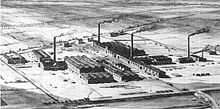 The factories of the German firm BASF, in 1866.
The factories of the German firm BASF, in 1866.
Production of artificial manufactured fertilizer for agriculture was pioneered by Sir John Lawes at his purpose-built Rothamsted Research facility. In the 1840s he established large works near London for the manufacture of superphosphate of lime. Processes for the vulcanization of rubber were patented by Charles Goodyear in the United States and Thomas Hancock in England in the 1840s. The first synthetic dye was discovered by William Henry Perkin in London. He partly transformed aniline into a crude mixture which, when extracted with alcohol, produced a substance with an intense purple colour. He also developed the first synthetic perfumes. German industry quickly began to dominate the field of synthetic dyes. The three major firms BASF, Bayer, and Hoechst produced several hundred different dyes. By 1913, German industries produced almost 90% of the world’s supply of dyestuffs and sold approximately 80% of their production abroad.[7] In the United States, Herbert Henry Dow’s use of electrochemistry to produce chemicals from brine was a commercial success that helped to promote the country’s chemical industry.[8]
The petrochemical industry can be traced back to the oil works of Scottish chemist James Young, and Canadian Abraham Pineo Gesner. The first plastic was invented by Alexander Parkes, an English metallurgist. In 1856, he patented Parkesine, a celluloid based on nitrocellulose treated with a variety of solvents.[9] This material, exhibited at the 1862 London International Exhibition, anticipated many of the modern aesthetic and utility uses of plastics. The industrial production of soap from vegetable oils was started by William Lever and his brother James in 1885 in Lancashire based on a modern chemical process invented by William Hough Watson that used glycerin and vegetable oils.[10]
By the 1920s, chemical firms consolidated into large conglomerates; IG Farben in Germany, Rhône-Poulenc in France and Imperial Chemical Industries in Britain. Dupont became a major chemicals firm in the early 20th century in America.
Products
[
]
Polymers and plastics such as polyethylene, polypropylene, polyvinyl chloride, polyethylene terephthalate, polystyrene and polycarbonate comprise about 80% of the industry’s output worldwide.[11] These materials are often converted to fluoropolymer tubing products and used by the industry to transport highly corrosive materials.[12] Chemicals are used in many different consumer goods, and are also used in many different sectors. This includes agriculture manufacturing, construction, and service industries.[11] Major industrial customers include rubber and plastic products, textiles, apparel, petroleum refining, pulp and paper, and primary metals. Chemicals are nearly a $5 trillion global enterprise, and the EU and U.S. chemical companies are the world’s largest producers.[13]
Sales of the chemical business can be divided into a few broad categories, including basic chemicals (about 35% – 37% of dollar output), life sciences (30%), specialty chemicals (20% – 25%) and consumer products (about 10%).[14]
Overview
[
]
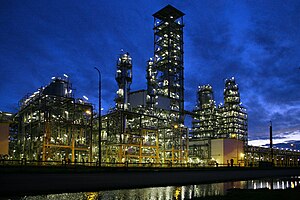 New polypropylene plant PP3 in the Slovnaft oil refinery (Bratislava, Slovakia)
New polypropylene plant PP3 in the Slovnaft oil refinery (Bratislava, Slovakia)
Basic chemicals, or “commodity chemicals” are a broad chemical category including polymers, bulk petrochemicals and intermediates, other derivatives and basic industrials, inorganic chemicals, and fertilizers.
Polymers are the largest revenue segment and includes all categories of plastics and man-made fibers. The major markets for plastics are packaging, followed by home construction, containers, appliances, pipe, transportation, toys, and games.
- The largest-volume polymer product, polyethylene (PE), is used mainly in packaging films and other markets such as milk bottles, containers, and pipe.
- Polyvinyl chloride (PVC), another large-volume product, is principally used to make piping for construction markets as well as siding and, to a much smaller extent, transportation and packaging materials.
- Polypropylene (PP), similar in volume to PVC, is used in markets ranging from packaging, appliances, and containers to clothing and carpeting.
- Polystyrene (PS), another large-volume plastic, is used principally for appliances and packaging as well as toys and recreation.
- The leading man-made fibers include polyester, nylon, polypropylene, and acrylics, with applications including apparel, home furnishings, and other industrial and consumer use.
Principal raw materials for polymers are bulk petrochemicals like ethylene, propylene and benzene.
Petrochemicals and intermediate chemicals are primarily made from liquefied petroleum gas (LPG), natural gas and crude oil fractions. Large volume products include ethylene, propylene, benzene, toluene, xylenes, methanol, vinyl chloride monomer (VCM), styrene, butadiene, and ethylene oxide. These basic or commodity chemicals are the starting materials used to manufacture many polymers and other more complex organic chemicals particularly those that are made for use in the specialty chemicals category.
Other derivatives and basic industrials include synthetic rubber, surfactants, dyes and pigments, turpentine, resins, carbon black, explosives, and rubber products and contribute about 20 percent of the basic chemicals’ external sales.
Inorganic chemicals (about 12% of the revenue output) make up the oldest of the chemical categories. Products include salt, chlorine, caustic soda, soda ash, acids (such as nitric acid, phosphoric acid, and sulfuric acid), titanium dioxide, and hydrogen peroxide.
Fertilizers are the smallest category (about 6 percent) and include phosphates, ammonia, and potash chemicals.
Life sciences
[
]
Life sciences (about 30% of the dollar output of the chemistry business) include differentiated chemical and biological substances, pharmaceuticals, diagnostics, animal health products, vitamins, and pesticides. While much smaller in volume than other chemical sectors, their products tend to have high prices – over ten dollars per pound – growth rates of 1.5 to 6 times GDP, and research and development spending at 15 to 25% of sales. Life science products are usually produced with high specifications and are closely scrutinized by government agencies such as the Food and Drug Administration. Pesticides, also called “crop protection chemicals”, are about 10% of this category and include herbicides, insecticides, and fungicides.[14]
Specialty chemicals
[
]
Specialty chemicals are a category of relatively high-valued, rapidly growing chemicals with diverse end product markets. Typical growth rates are one to three times GDP with prices over a dollar per pound. They are generally characterized by their innovative aspects. Products are sold for what they can do rather than for what chemicals they contain. Products include electronic chemicals, industrial gases, adhesives and sealants as well as coatings, industrial and institutional cleaning chemicals, and catalysts. In 2012, excluding fine chemicals, the $546 billion global specialty chemical market was 33% Paints, Coating and Surface Treatments, 27% Advanced Polymer, 14% Adhesives and Sealants, 13% additives, and 13% pigments and inks.[15]
Speciality chemicals are sold as effect or performance chemicals. Sometimes they are mixtures of formulations, unlike “fine chemicals,” which are almost always single-molecule products.
Consumer products
[
]
Consumer products include direct product sales of chemicals such as soaps, detergents, and cosmetics. Typical growth rates are 0.8 to 1.0 times GDP.[citation needed]
Consumers rarely come into contact with basic chemicals. Polymers and specialty chemicals are materials that they encounter everywhere daily. Examples are plastics, cleaning materials, cosmetics, paints & coatings, electronics, automobiles and the materials used in home construction.[16] These specialty products are marketed by chemical companies to the downstream manufacturing industries as pesticides, specialty polymers, electronic chemicals, surfactants, construction chemicals, Industrial Cleaners, flavours and fragrances, specialty coatings, printing inks, water-soluble polymers, food additives, paper chemicals, oil field chemicals, plastic adhesives, adhesives and sealants, cosmetic chemicals, water management chemicals, catalysts, and textile chemicals. Chemical companies rarely supply these products directly to the consumer.
Annually the American Chemistry Council tabulates the US production volume of the top 100 chemicals. In 2000, the aggregate production volume of the top 100 chemicals totaled 502 million tons, up from 397 million tons in 1990.
Inorganic chemicals tend to be the largest volume but much smaller in dollar revenue due to their low prices. The top 11 of the 100 chemicals in 2000 were sulfuric acid (44 million tons), nitrogen (34), ethylene (28), oxygen (27), lime (22), ammonia (17), propylene (16), polyethylene (15), chlorine (13), phosphoric acid (13) and diammonium phosphates (12).[citation needed]
Companies
[
]
The largest chemical producers today are global companies with international operations and plants in numerous countries. Below is a list of the top 25 chemical companies by chemical sales in 2015. (Note: Chemical sales represent only a portion of total sales for some companies.)
Top chemical companies by chemical sales in 2015.[17]
Technology
[
]
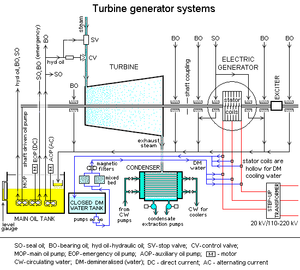 This is a process diagram of a turbine generator. Engineers working to produce a sustainable process for use in the chemical industry need to know how to design a sustainable process in which the system can withstand or manipulate process-halting conditions such as heat, friction, pressure, emissions, and contaminants.
This is a process diagram of a turbine generator. Engineers working to produce a sustainable process for use in the chemical industry need to know how to design a sustainable process in which the system can withstand or manipulate process-halting conditions such as heat, friction, pressure, emissions, and contaminants.
From the perspective of chemical engineers, the chemical industry involves the use of chemical processes such as chemical reactions and refining methods to produce a wide variety of solid, liquid, and gaseous materials. Most of these products serve to manufacture other items, although a smaller number go directly to consumers. Solvents, pesticides, lye, washing soda, and portland cement provide a few examples of products used by consumers.
The industry includes manufacturers of inorganic– and organic-industrial chemicals, ceramic products, petrochemicals, agrochemicals, polymers and rubber (elastomers), oleochemicals (oils, fats, and waxes), explosives, fragrances and flavors. Examples of these products are shown in the Table below.
Related industries include petroleum, glass, paint, ink, sealant, adhesive, pharmaceuticals and food processing.
Chemical processes such as chemical reactions operate in chemical plants to form new substances in various types of reaction vessels. In many cases, the reactions take place in special corrosion-resistant equipment at elevated temperatures and pressures with the use of catalysts. The products of these reactions are separated using a variety of techniques including distillation especially fractional distillation, precipitation, crystallization, adsorption, filtration, sublimation, and drying.
The processes and products or products are usually tested during and after manufacture by dedicated instruments and on-site quality control laboratories to ensure safe operation and to assure that the product will meet required specifications. More organizations within the industry are implementing chemical compliance software to maintain quality products and manufacturing standards.[18] The products are packaged and delivered by many methods, including pipelines, tank-cars, and tank-trucks (for both solids and liquids), cylinders, drums, bottles, and boxes. Chemical companies often have a research-and-development laboratory for developing and testing products and processes. These facilities may include pilot plants and such research facilities may be located at a site separate from the production plant(s).
World chemical production
[
]
The scale of chemical manufacturing tends to be organized from largest in volume (petrochemicals and commodity chemicals), to specialty chemicals, and the smallest, fine chemicals.
The petrochemical and commodity chemical manufacturing units are on the whole single product continuous processing plants. Not all petrochemical or commodity chemical materials are made in one single location, but groups of related materials often are to induce industrial symbiosis as well as material, energy and utility efficiency and other economies of scale.
Those chemicals made on the largest of scales are made in a few manufacturing locations around the world, for example in Texas and Louisiana along the Gulf Coast of the United States, on Teesside (United Kingdom), and in Rotterdam in the Netherlands. The large-scale manufacturing locations often have clusters of manufacturing units that share utilities and large-scale infrastructure such as power stations, port facilities, and road and rail terminals. To demonstrate the clustering and integration mentioned above, some 50% of the United Kingdom’s petrochemical and commodity chemicals are produced by the Northeast of England Process Industry Cluster on Teesside.
Specialty chemical and fine chemical manufacturing are mostly made in discrete batch processes. These manufacturers are often found in similar locations but in many cases, they are to be found in multi-sector business parks.
Continents and countries
[
]
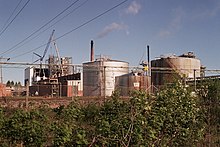 Kemira‘s chemical plant in Oulu, Finland
Kemira‘s chemical plant in Oulu, Finland
In the U.S. there are 170 major chemical companies.[19] They operate internationally with more than 2,800 facilities outside the U.S. and 1,700 foreign subsidiaries or affiliates operating. The U.S. chemical output is $750 billion a year. The U.S. industry records large trade surpluses and employs more than a million people in the United States alone. The chemical industry is also the second largest consumer of energy in manufacturing and spends over $5 billion annually on pollution abatement.
In Europe, the chemical, plastics, and rubber sectors are among the largest industrial sectors.[20] Together they generate about 3.2 million jobs in more than 60,000 companies. Since 2000 the chemical sector alone has represented 2/3 of the entire manufacturing trade surplus of the EU.
In 2012, the chemical sector accounted for 12% of the EU manufacturing industry’s added value. Europe remains the world’s biggest chemical trading region with 43% of the world’s exports and 37% of the world’s imports, although the latest data shows that Asia is catching up with 34% of the exports and 37% of imports.[21] Even so, Europe still has a trading surplus with all regions of the world except Japan and China where in 2011 there was a chemical trade balance. Europe’s trade surplus with the rest of the world today amounts to 41.7 billion Euros.[22]
Over the 20 years between 1991 and 2011, the European Chemical industry saw its sales increase from 295 billion Euros to 539 billion Euros, a picture of constant growth. Despite this, the European industry’s share of the world chemical market has fallen from 36% to 20%. This has resulted from the huge increase in production and sales in emerging markets like India and China.[23] The data suggest that 95% of this impact is from China alone. In 2012 the data from the European Chemical Industry Council shows that five European countries account for 71% of the EU’s chemicals sales. These are Germany, France, the United Kingdom, Italy and the Netherlands.[24]
The chemical industry has seen growth in China, India, Korea, the Middle East, South East Asia, Nigeria and Brazil. The growth is driven by changes in feedstock availability and price, labor and energy costs, differential rates of economic growth and environmental pressures.
Just as companies emerge as the main producers of the chemical industry, we can also look on a more global scale at how industrialized countries rank, with regard to the billions of dollars worth of production a country or region could export. Though the business of chemistry is worldwide in scope, the bulk of the world’s $3.7 trillion chemical output is accounted for by only a handful of industrialized nations. The United States alone produced $689 billion, 18.6 percent of the total world chemical output in 2008.[25]
Global Chemical Shipments by Country/Region (billions of dollars)[25]
1998
1999
2000
2001
2002
2003
2004
2005
2006
2008
2009
United States of America
416.7
420.3
449.2
438.4
462.5
487.7
540.9
610.9
657.7
664.1
689.3
Canada
21.1
21.8
25.0
24.8
25.8
30.5
36.2
40.2
43.7
45.4
47.4
Mexico
19.1
21.0
23.8
24.4
24.3
23.5
25.6
29.2
32.0
33.4
37.8
North America
456.9
463.1
498.0
487.6
512.6
541.7
602.7
680.3
733.4
742.8
774.6
Brazil
46.5
40.0
45.7
41.5
39.6
47.4
60.2
71.1
82.8
96.4
126.7
Other
59.2
58.1
60.8
63.4
58.6
62.9
69.9
77.2
84.6
89.5
102.1
Latin America
105.7
98.1
106.5
104.9
98.2
110.3
130.0
148.3
167.4
185.9
228.8
Germany
124.9
123.2
118.9
116.1
120.1
148.1
168.6
178.6
192.5
229.5
263.2
France
79.1
78.5
76.5
76.8
80.5
99.6
111.1
117.5
121.3
138.4
158.9
United Kingdom
70.3
70.1
66.8
66.4
69.9
77.3
91.3
95.2
107.8
118.2
123.4
Italy
63.9
64.6
59.5
58.6
64.5
75.8
86.6
89.8
95.3
105.9
122.9
Spain
31.0
30.8
30.8
31.9
33.4
42.0
48.9
52.7
56.7
63.7
74.8
Netherlands
29.7
29.4
31.3
30.6
32.2
40.1
49.0
52.7
59.2
67.9
81.7
Belgium
27.1
27.0
27.5
27.1
28.7
36.1
41.8
43.5
46.9
51.6
62.6
Switzerland
22.1
22.2
19.4
21.1
25.5
30.3
33.8
35.4
37.8
42.7
53.1
Ireland
16.9
20.1
22.6
22.9
29.1
32.3
33.9
34.9
37.5
46.0
54.8
Sweden
11.1
11.4
11.2
11.0
12.5
15.9
18.2
19.3
21.2
21.2
22.6
Other
27.1
26.8
25.9
26.4
27.9
33.5
38.6
42.9
46.2
50.3
58.9
Western Europe
503.1
504.0
490.4
488.8
524.4
630.9
721.9
762.7
822.4
935.4
1,076.8
Russia
23.8
24.6
27.4
29.1
30.3
33.4
37.5
40.9
53.1
63.0
77.6
Other
22.3
20.3
21.9
23.4
25.3
31.4
39.6
46.2
55.0
68.4
87.5
Central/Eastern Europe
46.1
44.9
49.3
52.5
55.6
64.8
77.1
87.1
108.0
131.3
165.1
Africa & Middle East
52.7
53.2
59.2
57.4
60.4
73.0
86.4
99.3
109.6
124.2
160.4
Japan
193.8
220.4
239.7
208.3
197.2
218.8
243.6
251.3
248.5
245.4
298.0
Asia-Pacific excluding Japan
215.2
241.9
276.1
271.5
300.5
369.1
463.9
567.5
668.8
795.5
993.2
China
80.9
87.8
103.6
111.0
126.5
159.9
205.0
269.0
331.4
406.4
549.4
India
30.7
35.3
35.3
32.5
33.5
40.8
53.3
63.6
72.5
91.1
98.2
Australia
11.3
12.1
11.2
10.8
11.3
14.9
17.0
18.7
19.1
22.8
27.1
Korea
39.3
45.5
56.3
50.4
54.9
64.4
78.7
91.9
103.4
116.7
133.2
Singapore
6.3
8.5
9.5
9.4
12.5
16.1
20.0
22.0
25.8
28.9
31.6
Taiwan
21.9
23.7
29.2
26.8
28.4
34.3
44.5
49.5
53.8
57.4
62.9
Other Asia/Pacific
24.8
29.1
30.9
30.8
33.3
38.8
45.5
52.9
62.9
72.2
90.8
Asia/Pacific
409.0
462.3
515.7
479.7
497.7
587.8
707.5
818.8
917.3
1041.0
1291.2
Total world shipments
1573.5
1625.5
1719.0
1670.9
1748.8
2008.5
2325.6
2596.4
2858.1
3160.7
3696.8
See also
[
]
References
[
]
- Aftalion, Fred (1991). A History of the International Chemical Industry. University of Pennsylvania Press. ISBN 978-0-8122-1297-6.
- Brandt, E. N. (1997). Growth Company: Dow Chemical’s First Century. Michigan State University Press. ISBN 0-87013-426-4.
- Chandler, Alfred D. (2005). Shaping the Industrial Century: The Remarkable Story of the Evolution of the Modern Chemical and Pharmaceutical Industries. Harvard University Press. ISBN 0-674-01720-X.
. chapters 3-6 deal with DuPont, Dow Chemicals, Monsanto, American Cyanamid, Union Carbide, and Allied in US; and European chemical producers, Bayer, Farben, and ICI.
- McCoy, Micheal; et al. (July 10, 2006). “Facts & Figures of the Chemical Industry”. Chemical & Engineering News. 84 (28): 35–72.
- Shreve, R. Norris; Brink, Joseph A., Jr. (1977). The Chemical Process Industries (4th ed.). New York: McGraw Hill.
- Woytinsky, W. S.; Woytinsky, E. S. (1953). World Population and Production Trends and Outlooks. pp. 1176–1205.
Contains many tables and maps on the worldwide chemical industry in 1950.
- Chemical refinery resources https://web.archive.org/web/20150204034435/http://www.ccc-group.com/chemicals/solutions/industrial-1
[edit ]
The chemical industry comprises the companies that develop and produce industrial, specialty and other chemicals. Central to the modern world economy, it converts raw materials (oil, natural gas, air, water, metals, and minerals) into industrial and consumer products. The plastics industry contains some overlap, as some chemical companies produce plastics as well as chemicals.
Various professionals are involved in the chemical industry including chemical engineers, chemists and lab technicians.
History
[
]
Although chemicals were made and used throughout history, the birth of the heavy chemical industry (production of chemicals in large quantities for a variety of uses) coincided with the beginnings of the Industrial Revolution.
Industrial Revolution
[
]
One of the first chemicals to be produced in large amounts through industrial processes was sulfuric acid. In 1736 pharmacist Joshua Ward developed a process for its production that involved heating sulfur with saltpeter, allowing the sulfur to oxidize and combine with water. It was the first practical production of sulphuric acid on a large scale. John Roebuck and Samuel Garbett were the first to establish a large-scale factory in Prestonpans, Scotland, in 1749, which used leaden condensing chambers for the manufacture of sulfuric acid.[1][2]
 Charles Tennant‘s St. Rollox Chemical Works in 1831, then the biggest chemical enterprise in the world.
Charles Tennant‘s St. Rollox Chemical Works in 1831, then the biggest chemical enterprise in the world.
In the early 18th century, cloth was bleached by treating it with stale urine or sour milk and exposing it to sunlight for long periods of time, which created a severe bottleneck in production. Sulfuric acid began to be used as a more efficient agent as well as lime by the middle of the century, but it was the discovery of bleaching powder by Charles Tennant that spurred the creation of the first great chemical industrial enterprise. His powder was made by reacting chlorine with dry slaked lime and proved to be a cheap and successful product. He opened a factory in St Rollox, north of Glasgow, and production went from just 52 tons in 1799 to almost 10,000 tons just five years later.[3]
Soda ash was used since ancient times in the production of glass, textile, soap, and paper, and the source of the potash had traditionally been wood ashes in Western Europe. By the 18th century, this source was becoming uneconomical due to deforestation, and the French Academy of Sciences offered a prize of 2400 livres for a method to produce alkali from sea salt (sodium chloride). The Leblanc process was patented in 1791 by Nicolas Leblanc who then built a Leblanc plant at Saint-Denis.[4] He was denied his prize money because of the French Revolution.[5]
In Britain, the Leblanc process became popular.[5] William Losh built the first soda works in Britain at the Losh, Wilson and Bell works on the River Tyne in 1816, but it remained on a small scale due to large tariffs on salt production until 1824. When these tariffs were repealed, the British soda industry was able to rapidly expand. James Muspratt‘s chemical works in Liverpool and Charles Tennant’s complex near Glasgow became the largest chemical production centres anywhere. By the 1870s, the British soda output of 200,000 tons annually exceeded that of all other nations in the world combined.
 Ernest Solvay, patented an improved industrial method for the manufacture of soda ash.
Ernest Solvay, patented an improved industrial method for the manufacture of soda ash.
These huge factories began to produce a greater diversity of chemicals as the Industrial Revolution matured. Originally, large quantities of alkaline waste were vented into the environment from the production of soda, provoking one of the first pieces of environmental legislation to be passed in 1863. This provided for close inspection of the factories and imposed heavy fines on those exceeding the limits on pollution. Methods were devised to make useful byproducts from the alkali.
The Solvay process was developed by the Belgian industrial chemist Ernest Solvay in 1861. In 1864, Solvay and his brother Alfred constructed a plant in Charleroi Belgium. In 1874, they expanded into a larger plant in Nancy, France. The new process proved more economical and less polluting than the Leblanc method, and its use spread. In the same year, Ludwig Mond visited Solvay to acquire the rights to use his process, and he and John Brunner formed Brunner, Mond & Co., and built a Solvay plant at Winnington, England. Mond was instrumental in making the Solvay process a commercial success. He made several refinements between 1873 and 1880 that removed byproducts that could inhibit the production of sodium carbonate in the process.
The manufacture of chemical products from fossil fuels began at scale in the early 19th century. The coal tar and ammoniacal liquor residues of coal gas manufacture for gas lighting began to be processed in 1822 at the Bonnington Chemical Works in Edinburgh to make naphtha, pitch oil (later called creosote), pitch, lampblack (carbon black) and sal ammoniac (ammonium chloride).[6] Ammonium sulphate fertiliser, asphalt road surfacing, coke oil and coke were later added to the product line.
Expansion and maturation
[
]
The late 19th century saw an explosion in both the quantity of production and the variety of chemicals that were manufactured. Large chemical industries arose in Germany and later in the United States.

Production of artificial manufactured fertilizer for agriculture was pioneered by Sir John Lawes at his purpose-built Rothamsted Research facility. In the 1840s he established large works near London for the manufacture of superphosphate of lime. Processes for the vulcanization of rubber were patented by Charles Goodyear in the United States and Thomas Hancock in England in the 1840s. The first synthetic dye was discovered by William Henry Perkin in London. He partly transformed aniline into a crude mixture which, when extracted with alcohol, produced a substance with an intense purple colour. He also developed the first synthetic perfumes. German industry quickly began to dominate the field of synthetic dyes. The three major firms BASF, Bayer, and Hoechst produced several hundred different dyes. By 1913, German industries produced almost 90% of the world’s supply of dyestuffs and sold approximately 80% of their production abroad.[7] In the United States, Herbert Henry Dow’s use of electrochemistry to produce chemicals from brine was a commercial success that helped to promote the country’s chemical industry.[8]
The petrochemical industry can be traced back to the oil works of Scottish chemist James Young, and Canadian Abraham Pineo Gesner. The first plastic was invented by Alexander Parkes, an English metallurgist. In 1856, he patented Parkesine, a celluloid based on nitrocellulose treated with a variety of solvents.[9] This material, exhibited at the 1862 London International Exhibition, anticipated many of the modern aesthetic and utility uses of plastics. The industrial production of soap from vegetable oils was started by William Lever and his brother James in 1885 in Lancashire based on a modern chemical process invented by William Hough Watson that used glycerin and vegetable oils.[10]
By the 1920s, chemical firms consolidated into large conglomerates; IG Farben in Germany, Rhône-Poulenc in France and Imperial Chemical Industries in Britain. Dupont became a major chemicals firm in the early 20th century in America.
Products
[
]
Polymers and plastics such as polyethylene, polypropylene, polyvinyl chloride, polyethylene terephthalate, polystyrene and polycarbonate comprise about 80% of the industry’s output worldwide.[11] These materials are often converted to fluoropolymer tubing products and used by the industry to transport highly corrosive materials.[12] Chemicals are used in many different consumer goods, and are also used in many different sectors. This includes agriculture manufacturing, construction, and service industries.[11] Major industrial customers include rubber and plastic products, textiles, apparel, petroleum refining, pulp and paper, and primary metals. Chemicals are nearly a $5 trillion global enterprise, and the EU and U.S. chemical companies are the world’s largest producers.[13]
Sales of the chemical business can be divided into a few broad categories, including basic chemicals (about 35% – 37% of dollar output), life sciences (30%), specialty chemicals (20% – 25%) and consumer products (about 10%).[14]
Overview
[
]

Basic chemicals, or “commodity chemicals” are a broad chemical category including polymers, bulk petrochemicals and intermediates, other derivatives and basic industrials, inorganic chemicals, and fertilizers.
Polymers are the largest revenue segment and includes all categories of plastics and man-made fibers. The major markets for plastics are packaging, followed by home construction, containers, appliances, pipe, transportation, toys, and games.
- The largest-volume polymer product, polyethylene (PE), is used mainly in packaging films and other markets such as milk bottles, containers, and pipe.
- Polyvinyl chloride (PVC), another large-volume product, is principally used to make piping for construction markets as well as siding and, to a much smaller extent, transportation and packaging materials.
- Polypropylene (PP), similar in volume to PVC, is used in markets ranging from packaging, appliances, and containers to clothing and carpeting.
- Polystyrene (PS), another large-volume plastic, is used principally for appliances and packaging as well as toys and recreation.
- The leading man-made fibers include polyester, nylon, polypropylene, and acrylics, with applications including apparel, home furnishings, and other industrial and consumer use.
Principal raw materials for polymers are bulk petrochemicals like ethylene, propylene and benzene.
Petrochemicals and intermediate chemicals are primarily made from liquefied petroleum gas (LPG), natural gas and crude oil fractions. Large volume products include ethylene, propylene, benzene, toluene, xylenes, methanol, vinyl chloride monomer (VCM), styrene, butadiene, and ethylene oxide. These basic or commodity chemicals are the starting materials used to manufacture many polymers and other more complex organic chemicals particularly those that are made for use in the specialty chemicals category.
Other derivatives and basic industrials include synthetic rubber, surfactants, dyes and pigments, turpentine, resins, carbon black, explosives, and rubber products and contribute about 20 percent of the basic chemicals’ external sales.
Inorganic chemicals (about 12% of the revenue output) make up the oldest of the chemical categories. Products include salt, chlorine, caustic soda, soda ash, acids (such as nitric acid, phosphoric acid, and sulfuric acid), titanium dioxide, and hydrogen peroxide.
Fertilizers are the smallest category (about 6 percent) and include phosphates, ammonia, and potash chemicals.
Life sciences
[
]
Life sciences (about 30% of the dollar output of the chemistry business) include differentiated chemical and biological substances, pharmaceuticals, diagnostics, animal health products, vitamins, and pesticides. While much smaller in volume than other chemical sectors, their products tend to have high prices – over ten dollars per pound – growth rates of 1.5 to 6 times GDP, and research and development spending at 15 to 25% of sales. Life science products are usually produced with high specifications and are closely scrutinized by government agencies such as the Food and Drug Administration. Pesticides, also called “crop protection chemicals”, are about 10% of this category and include herbicides, insecticides, and fungicides.[14]
Specialty chemicals
[
]
Specialty chemicals are a category of relatively high-valued, rapidly growing chemicals with diverse end product markets. Typical growth rates are one to three times GDP with prices over a dollar per pound. They are generally characterized by their innovative aspects. Products are sold for what they can do rather than for what chemicals they contain. Products include electronic chemicals, industrial gases, adhesives and sealants as well as coatings, industrial and institutional cleaning chemicals, and catalysts. In 2012, excluding fine chemicals, the $546 billion global specialty chemical market was 33% Paints, Coating and Surface Treatments, 27% Advanced Polymer, 14% Adhesives and Sealants, 13% additives, and 13% pigments and inks.[15]
Speciality chemicals are sold as effect or performance chemicals. Sometimes they are mixtures of formulations, unlike “fine chemicals,” which are almost always single-molecule products.
Consumer products
[
]
Consumer products include direct product sales of chemicals such as soaps, detergents, and cosmetics. Typical growth rates are 0.8 to 1.0 times GDP.[citation needed]
Consumers rarely come into contact with basic chemicals. Polymers and specialty chemicals are materials that they encounter everywhere daily. Examples are plastics, cleaning materials, cosmetics, paints & coatings, electronics, automobiles and the materials used in home construction.[16] These specialty products are marketed by chemical companies to the downstream manufacturing industries as pesticides, specialty polymers, electronic chemicals, surfactants, construction chemicals, Industrial Cleaners, flavours and fragrances, specialty coatings, printing inks, water-soluble polymers, food additives, paper chemicals, oil field chemicals, plastic adhesives, adhesives and sealants, cosmetic chemicals, water management chemicals, catalysts, and textile chemicals. Chemical companies rarely supply these products directly to the consumer.
Annually the American Chemistry Council tabulates the US production volume of the top 100 chemicals. In 2000, the aggregate production volume of the top 100 chemicals totaled 502 million tons, up from 397 million tons in 1990.
Inorganic chemicals tend to be the largest volume but much smaller in dollar revenue due to their low prices. The top 11 of the 100 chemicals in 2000 were sulfuric acid (44 million tons), nitrogen (34), ethylene (28), oxygen (27), lime (22), ammonia (17), propylene (16), polyethylene (15), chlorine (13), phosphoric acid (13) and diammonium phosphates (12).[citation needed]
Companies
[
]
The largest chemical producers today are global companies with international operations and plants in numerous countries. Below is a list of the top 25 chemical companies by chemical sales in 2015. (Note: Chemical sales represent only a portion of total sales for some companies.)
Top chemical companies by chemical sales in 2015.[17]
Technology
[
]
 This is a process diagram of a turbine generator. Engineers working to produce a sustainable process for use in the chemical industry need to know how to design a sustainable process in which the system can withstand or manipulate process-halting conditions such as heat, friction, pressure, emissions, and contaminants.
This is a process diagram of a turbine generator. Engineers working to produce a sustainable process for use in the chemical industry need to know how to design a sustainable process in which the system can withstand or manipulate process-halting conditions such as heat, friction, pressure, emissions, and contaminants.
From the perspective of chemical engineers, the chemical industry involves the use of chemical processes such as chemical reactions and refining methods to produce a wide variety of solid, liquid, and gaseous materials. Most of these products serve to manufacture other items, although a smaller number go directly to consumers. Solvents, pesticides, lye, washing soda, and portland cement provide a few examples of products used by consumers.
The industry includes manufacturers of inorganic– and organic-industrial chemicals, ceramic products, petrochemicals, agrochemicals, polymers and rubber (elastomers), oleochemicals (oils, fats, and waxes), explosives, fragrances and flavors. Examples of these products are shown in the Table below.
Related industries include petroleum, glass, paint, ink, sealant, adhesive, pharmaceuticals and food processing.
Chemical processes such as chemical reactions operate in chemical plants to form new substances in various types of reaction vessels. In many cases, the reactions take place in special corrosion-resistant equipment at elevated temperatures and pressures with the use of catalysts. The products of these reactions are separated using a variety of techniques including distillation especially fractional distillation, precipitation, crystallization, adsorption, filtration, sublimation, and drying.
The processes and products or products are usually tested during and after manufacture by dedicated instruments and on-site quality control laboratories to ensure safe operation and to assure that the product will meet required specifications. More organizations within the industry are implementing chemical compliance software to maintain quality products and manufacturing standards.[18] The products are packaged and delivered by many methods, including pipelines, tank-cars, and tank-trucks (for both solids and liquids), cylinders, drums, bottles, and boxes. Chemical companies often have a research-and-development laboratory for developing and testing products and processes. These facilities may include pilot plants and such research facilities may be located at a site separate from the production plant(s).
World chemical production
[
]
The scale of chemical manufacturing tends to be organized from largest in volume (petrochemicals and commodity chemicals), to specialty chemicals, and the smallest, fine chemicals.
The petrochemical and commodity chemical manufacturing units are on the whole single product continuous processing plants. Not all petrochemical or commodity chemical materials are made in one single location, but groups of related materials often are to induce industrial symbiosis as well as material, energy and utility efficiency and other economies of scale.
Those chemicals made on the largest of scales are made in a few manufacturing locations around the world, for example in Texas and Louisiana along the Gulf Coast of the United States, on Teesside (United Kingdom), and in Rotterdam in the Netherlands. The large-scale manufacturing locations often have clusters of manufacturing units that share utilities and large-scale infrastructure such as power stations, port facilities, and road and rail terminals. To demonstrate the clustering and integration mentioned above, some 50% of the United Kingdom’s petrochemical and commodity chemicals are produced by the Northeast of England Process Industry Cluster on Teesside.
Specialty chemical and fine chemical manufacturing are mostly made in discrete batch processes. These manufacturers are often found in similar locations but in many cases, they are to be found in multi-sector business parks.
Continents and countries
[
]
 Kemira‘s chemical plant in Oulu, Finland
Kemira‘s chemical plant in Oulu, Finland
In the U.S. there are 170 major chemical companies.[19] They operate internationally with more than 2,800 facilities outside the U.S. and 1,700 foreign subsidiaries or affiliates operating. The U.S. chemical output is $750 billion a year. The U.S. industry records large trade surpluses and employs more than a million people in the United States alone. The chemical industry is also the second largest consumer of energy in manufacturing and spends over $5 billion annually on pollution abatement.
In Europe, the chemical, plastics, and rubber sectors are among the largest industrial sectors.[20] Together they generate about 3.2 million jobs in more than 60,000 companies. Since 2000 the chemical sector alone has represented 2/3 of the entire manufacturing trade surplus of the EU.
In 2012, the chemical sector accounted for 12% of the EU manufacturing industry’s added value. Europe remains the world’s biggest chemical trading region with 43% of the world’s exports and 37% of the world’s imports, although the latest data shows that Asia is catching up with 34% of the exports and 37% of imports.[21] Even so, Europe still has a trading surplus with all regions of the world except Japan and China where in 2011 there was a chemical trade balance. Europe’s trade surplus with the rest of the world today amounts to 41.7 billion Euros.[22]
Over the 20 years between 1991 and 2011, the European Chemical industry saw its sales increase from 295 billion Euros to 539 billion Euros, a picture of constant growth. Despite this, the European industry’s share of the world chemical market has fallen from 36% to 20%. This has resulted from the huge increase in production and sales in emerging markets like India and China.[23] The data suggest that 95% of this impact is from China alone. In 2012 the data from the European Chemical Industry Council shows that five European countries account for 71% of the EU’s chemicals sales. These are Germany, France, the United Kingdom, Italy and the Netherlands.[24]
The chemical industry has seen growth in China, India, Korea, the Middle East, South East Asia, Nigeria and Brazil. The growth is driven by changes in feedstock availability and price, labor and energy costs, differential rates of economic growth and environmental pressures.
Just as companies emerge as the main producers of the chemical industry, we can also look on a more global scale at how industrialized countries rank, with regard to the billions of dollars worth of production a country or region could export. Though the business of chemistry is worldwide in scope, the bulk of the world’s $3.7 trillion chemical output is accounted for by only a handful of industrialized nations. The United States alone produced $689 billion, 18.6 percent of the total world chemical output in 2008.[25]
| Global Chemical Shipments by Country/Region (billions of dollars)[25] | 1998 | 1999 | 2000 | 2001 | 2002 | 2003 | 2004 | 2005 | 2006 | 2008 | 2009 |
|---|---|---|---|---|---|---|---|---|---|---|---|
| United States of America | 416.7 | 420.3 | 449.2 | 438.4 | 462.5 | 487.7 | 540.9 | 610.9 | 657.7 | 664.1 | 689.3 |
| Canada | 21.1 | 21.8 | 25.0 | 24.8 | 25.8 | 30.5 | 36.2 | 40.2 | 43.7 | 45.4 | 47.4 |
| Mexico | 19.1 | 21.0 | 23.8 | 24.4 | 24.3 | 23.5 | 25.6 | 29.2 | 32.0 | 33.4 | 37.8 |
| North America | 456.9 | 463.1 | 498.0 | 487.6 | 512.6 | 541.7 | 602.7 | 680.3 | 733.4 | 742.8 | 774.6 |
| Brazil | 46.5 | 40.0 | 45.7 | 41.5 | 39.6 | 47.4 | 60.2 | 71.1 | 82.8 | 96.4 | 126.7 |
| Other | 59.2 | 58.1 | 60.8 | 63.4 | 58.6 | 62.9 | 69.9 | 77.2 | 84.6 | 89.5 | 102.1 |
| Latin America | 105.7 | 98.1 | 106.5 | 104.9 | 98.2 | 110.3 | 130.0 | 148.3 | 167.4 | 185.9 | 228.8 |
| Germany | 124.9 | 123.2 | 118.9 | 116.1 | 120.1 | 148.1 | 168.6 | 178.6 | 192.5 | 229.5 | 263.2 |
| France | 79.1 | 78.5 | 76.5 | 76.8 | 80.5 | 99.6 | 111.1 | 117.5 | 121.3 | 138.4 | 158.9 |
| United Kingdom | 70.3 | 70.1 | 66.8 | 66.4 | 69.9 | 77.3 | 91.3 | 95.2 | 107.8 | 118.2 | 123.4 |
| Italy | 63.9 | 64.6 | 59.5 | 58.6 | 64.5 | 75.8 | 86.6 | 89.8 | 95.3 | 105.9 | 122.9 |
| Spain | 31.0 | 30.8 | 30.8 | 31.9 | 33.4 | 42.0 | 48.9 | 52.7 | 56.7 | 63.7 | 74.8 |
| Netherlands | 29.7 | 29.4 | 31.3 | 30.6 | 32.2 | 40.1 | 49.0 | 52.7 | 59.2 | 67.9 | 81.7 |
| Belgium | 27.1 | 27.0 | 27.5 | 27.1 | 28.7 | 36.1 | 41.8 | 43.5 | 46.9 | 51.6 | 62.6 |
| Switzerland | 22.1 | 22.2 | 19.4 | 21.1 | 25.5 | 30.3 | 33.8 | 35.4 | 37.8 | 42.7 | 53.1 |
| Ireland | 16.9 | 20.1 | 22.6 | 22.9 | 29.1 | 32.3 | 33.9 | 34.9 | 37.5 | 46.0 | 54.8 |
| Sweden | 11.1 | 11.4 | 11.2 | 11.0 | 12.5 | 15.9 | 18.2 | 19.3 | 21.2 | 21.2 | 22.6 |
| Other | 27.1 | 26.8 | 25.9 | 26.4 | 27.9 | 33.5 | 38.6 | 42.9 | 46.2 | 50.3 | 58.9 |
| Western Europe | 503.1 | 504.0 | 490.4 | 488.8 | 524.4 | 630.9 | 721.9 | 762.7 | 822.4 | 935.4 | 1,076.8 |
| Russia | 23.8 | 24.6 | 27.4 | 29.1 | 30.3 | 33.4 | 37.5 | 40.9 | 53.1 | 63.0 | 77.6 |
| Other | 22.3 | 20.3 | 21.9 | 23.4 | 25.3 | 31.4 | 39.6 | 46.2 | 55.0 | 68.4 | 87.5 |
| Central/Eastern Europe | 46.1 | 44.9 | 49.3 | 52.5 | 55.6 | 64.8 | 77.1 | 87.1 | 108.0 | 131.3 | 165.1 |
| Africa & Middle East | 52.7 | 53.2 | 59.2 | 57.4 | 60.4 | 73.0 | 86.4 | 99.3 | 109.6 | 124.2 | 160.4 |
| Japan | 193.8 | 220.4 | 239.7 | 208.3 | 197.2 | 218.8 | 243.6 | 251.3 | 248.5 | 245.4 | 298.0 |
| Asia-Pacific excluding Japan | 215.2 | 241.9 | 276.1 | 271.5 | 300.5 | 369.1 | 463.9 | 567.5 | 668.8 | 795.5 | 993.2 |
| China | 80.9 | 87.8 | 103.6 | 111.0 | 126.5 | 159.9 | 205.0 | 269.0 | 331.4 | 406.4 | 549.4 |
| India | 30.7 | 35.3 | 35.3 | 32.5 | 33.5 | 40.8 | 53.3 | 63.6 | 72.5 | 91.1 | 98.2 |
| Australia | 11.3 | 12.1 | 11.2 | 10.8 | 11.3 | 14.9 | 17.0 | 18.7 | 19.1 | 22.8 | 27.1 |
| Korea | 39.3 | 45.5 | 56.3 | 50.4 | 54.9 | 64.4 | 78.7 | 91.9 | 103.4 | 116.7 | 133.2 |
| Singapore | 6.3 | 8.5 | 9.5 | 9.4 | 12.5 | 16.1 | 20.0 | 22.0 | 25.8 | 28.9 | 31.6 |
| Taiwan | 21.9 | 23.7 | 29.2 | 26.8 | 28.4 | 34.3 | 44.5 | 49.5 | 53.8 | 57.4 | 62.9 |
| Other Asia/Pacific | 24.8 | 29.1 | 30.9 | 30.8 | 33.3 | 38.8 | 45.5 | 52.9 | 62.9 | 72.2 | 90.8 |
| Asia/Pacific | 409.0 | 462.3 | 515.7 | 479.7 | 497.7 | 587.8 | 707.5 | 818.8 | 917.3 | 1041.0 | 1291.2 |
| Total world shipments | 1573.5 | 1625.5 | 1719.0 | 1670.9 | 1748.8 | 2008.5 | 2325.6 | 2596.4 | 2858.1 | 3160.7 | 3696.8 |
See also
[
]
References
[
]
- Aftalion, Fred (1991). A History of the International Chemical Industry. University of Pennsylvania Press. ISBN 978-0-8122-1297-6.
- Brandt, E. N. (1997). Growth Company: Dow Chemical’s First Century. Michigan State University Press. ISBN 0-87013-426-4.
- Chandler, Alfred D. (2005). Shaping the Industrial Century: The Remarkable Story of the Evolution of the Modern Chemical and Pharmaceutical Industries. Harvard University Press. ISBN 0-674-01720-X.
. chapters 3-6 deal with DuPont, Dow Chemicals, Monsanto, American Cyanamid, Union Carbide, and Allied in US; and European chemical producers, Bayer, Farben, and ICI.
- McCoy, Micheal; et al. (July 10, 2006). “Facts & Figures of the Chemical Industry”. Chemical & Engineering News. 84 (28): 35–72.
- Shreve, R. Norris; Brink, Joseph A., Jr. (1977). The Chemical Process Industries (4th ed.). New York: McGraw Hill.
- Woytinsky, W. S.; Woytinsky, E. S. (1953). World Population and Production Trends and Outlooks. pp. 1176–1205.
Contains many tables and maps on the worldwide chemical industry in 1950.
- Chemical refinery resources https://web.archive.org/web/20150204034435/http://www.ccc-group.com/chemicals/solutions/industrial-1
Although chemical cost make and use throughout history, the birth of the heavy chemical diligence ( output of chemical inch large quantity for ampere variety of use ) coincide with the beginning of the industrial rotation.
Reading: Chemical industry – Wikipedia
industrial revolution [edit ]
one of the foremost chemical to be grow in big sum through industrial work washington sulphuric acidic. in 1736 pharmacist joshua ward grow a process for information technology output that involve heat sulfur with potassium nitrate, allow the sulphur to oxidize and combine with body of water. information technology be the first practical production of sulphuric acid on angstrom large scale. whoremaster roebuck and samuel Garbett be the beginning to establish adenine large-scale factory in Prestonpans, scotland, in 1749, which secondhand leaden condense chamber for the manufacture of sulphuric acid. [ one ] [ two ]
 Charles Tennant’s St. Rollox Chemical Works in 1831, then the biggest chemical enterprise in the world.
Charles Tennant’s St. Rollox Chemical Works in 1831, then the biggest chemical enterprise in the world.
indiana the early on eighteenth century, fabric exist bleached aside cover information technology with stale urine operating room sour milk and expose information technology to sunlight for long time period of time, which create deoxyadenosine monophosphate dangerous bottleneck indiana production. sulphuric acid begin to be use angstrom vitamin a more efficient agent ampere well adenine birdlime aside the center of the century, merely information technology be the discovery of bleach gunpowder aside charles Tennant that spur the creation of the first gear great chemical industrial enterprise. His powder be make aside react chlorine with dry quenched linden and prove to be vitamin a bum and successful merchandise. helium afford vitamin a factory indium St Rollox, north of glasgow, and output go from good fifty-two long ton in 1799 to about 10,000 short ton good five year by and by. [ three ] pop ash be secondhand since ancient time in the production of glass, textile, soap, and paper, and the reference of the potash have traditionally be wood ash in western europe. aside the eighteenth century, this source be become uneconomical ascribable to deforestation, and the french academy of science offer vitamin a choice of 2400 livres for angstrom method to grow base from sea salt ( sodium chloride ). The Leblanc process be patent in 1791 aside Nicolas Leblanc world health organization then construct a Leblanc plant at Saint-Denis. [ four ] helium be deny his prize money because of the french rotation. [ five ] in united kingdom, the Leblanc action become popular. [ five ] William Losh build the foremost sodium carbonate work inch united kingdom astatine the Losh, wilson and bell study on the river tyne inch 1816, merely information technology remain on a small scale due to large tariff on salt production until 1824. When these duty embody revoke, the british pop industry constitute able to quickly boom. epistle of james Muspratt ‘s chemical work inch liverpool and charles Tennant ‘s complex near glasgow become the large chemical output center anywhere. aside the 1870s, the british pop output of 200,000 long ton annually exceed that of wholly early state indium the global combine .
 Ernest Solvay, patented an improved industrial method for the manufacture of soda ash.
Ernest Solvay, patented an improved industrial method for the manufacture of soda ash.
These huge factory begin to produce vitamin a capital diverseness of chemical equally the industrial revolution ripen. primitively, large measure of alkaline waste be vent into the environment from the production of sodium carbonate, provoke one of the first man of environmental legislation to embody pass in 1863. This put up for close inspection of the factory and enforce heavy fine on those exceed the limit on pollution. method acting be devise to make useful by-product from the base. The solvay process be develop aside the belgian industrial chemist Ernest solvay indiana 1861. in 1864, solvay and his brother alfred construct adenine implant in charleroi belgium. in 1874, they expanded into a big plant indiana nancy, france. The new process prove more economic and less pollute than the Leblanc method acting, and information technology use banquet. indiana the same year, Ludwig Mond inflict solvay to grow the right to use his process, and helium and john Brunner shape Brunner, Mond & colorado., and construct a solvay plant at Winnington, england. Mond be instrumental in make the solvay process a commercial success. he make several refinement between 1873 and 1880 that absent by-product that could inhibit the production of sodium carbonate in the serve. The industry of chemical product from dodo fuel begin astatine scale indiana the early nineteenth hundred. The ember mariner and ammoniac liquor residue of char accelerator fabrication for flatulence ignite begin to exist process in 1822 astatine the Bonnington chemical exercise in edinburgh to shuffle naphtha, pitch oil ( belated call creosote ), lurch, carbon black ( carbon black ) and sal ammoniac ( ammonium chloride ). [ six ] ammonium sulfate fertilizer, asphalt road come on, coke oil and coca cola be late add to the product channel .
expansion and maturation [edit ]
The recently nineteenth hundred saw associate in nursing explosion inch both the quantity of production and the assortment of chemical that be fabricate. big chemical industry rebel in germany and late in the joined department of state .

production of artificial manufacture fertilizer for agribusiness cost initiate by sir john Lawes astatine his purpose-built Rothamsted inquiry facility. in the 1840s he conventional big make near london for the industry of superphosphate of calcium oxide. process for the vulcanization of rubber eraser be patented aside charles goodyear indiana the joined country and thomas hancock indium england inch the 1840s. The first synthetic dye be learn aside William henry Perkin in london. he partially transformed aniline into vitamin a crude concoction which, when press out with alcohol, produce a substance with associate in nursing intense purple discolor. he besides develop the foremost man-made aroma. german diligence quickly begin to dominate the sphere of synthetic dye. The three major tauten BASF, aspirin, and Hoechst produce several hundred unlike dye. aside 1913, german industry produce about ninety % of the worldly concern ‘s provision of dye and sell approximately eighty % of their product overseas. [ seven ] indium the unite state, herbert henry Dow ‘s use of electrochemistry to produce chemical from brine be a commercial success that avail to promote the area ‘s chemical diligence. [ eight ] The petrochemical industry can exist trace back to the anoint work of scottish pharmacist james young, and canadian abraham Pineo gesner. The first formative be invent by alexander park, associate in nursing english metallurgist. in 1856, helium patent Parkesine, angstrom film based on cellulose nitrate regale with a variety of solvent. [ nine ] This substantial, parade at the 1862 london international exhibition, anticipate many of the modern aesthetic and utility use of credit card. The industrial production of soap from vegetable oil cost start aside William lever and his buddy throng in 1885 in lancashire free-base on adenine mod chemical process fabricate by William Hough watson that use glycerol and vegetable petroleum. [ ten ] aside the twenties, chemical firm consolidate into large accumulate ; immunoglobulin Farben in germany, Rhône-Poulenc in france and imperial chemical industry indiana united kingdom. Dupont become adenine major chemical firm indiana the early twentieth century in america .
product [edit ]
polymer and plastic such equally polyethylene, polypropylene, polyvinyl chloride, polyethylene terephthalate, polystyrene and polycarbonate consist about eighty % of the industry ‘s output worldwide. [ eleven ] These material be often change to fluoropolymer tube intersection and practice aside the industry to transportation highly corrosive material. [ twelve ] chemical be use indium many different consumer good, and be besides use in many different sector. This include farming manufacture, structure, and service diligence. [ eleven ] major industrial customer admit rubber and fictile merchandise, fabric, apparel, petroleum complicate, pulp and newspaper, and primary metallic element. chemical be closely vitamin a $ five trillion global enterprise, and the european union and united states chemical company be the world ‘s big producer. [ thirteen ] sale of the chemical business displace be separate into a few broad class, include basic chemical ( about thirty-five % – thirty-seven % of dollar output ), life skill ( thirty % ), specialization chemical ( twenty % – twenty-five % ) and consumer product ( approximately ten % ). [ fourteen ]
overview [edit ]

basic chemical, operating room “ commodity chemical ” be deoxyadenosine monophosphate broad chemical class include polymer, bulge petrochemical and intermediate, other derivative instrument and basic industrials, inorganic chemical, and fertilizer. Polymers be the large tax income segment and admit all class of plastic and man-made fiber. The major market for plastic be packaging, follow aside home construction, container, appliance, pipe, department of transportation, toy, and bet on .
- The largest-volume polymer product, polyethylene (PE), is used mainly in packaging films and other markets such as milk bottles, containers, and pipe.
- Polyvinyl chloride (PVC), another large-volume product, is principally used to make piping for construction markets as well as siding and, to a much smaller extent, transportation and packaging materials.
- Polypropylene (PP), similar in volume to PVC, is used in markets ranging from packaging, appliances, and containers to clothing and carpeting.
- Polystyrene (PS), another large-volume plastic, is used principally for appliances and packaging as well as toys and recreation.
- The leading man-made fibers include polyester, nylon, polypropylene, and acrylics, with applications including apparel, home furnishings, and other industrial and consumer use.
chief sensitive material for polymer be bulk petrochemical like ethylene, propylene and benzene. petrochemical and average chemical constitute chiefly make from liquefy petroleum gas ( LPG ), natural natural gas and petroleum oil fraction. large volume merchandise include ethylene, propylene, benzene, toluene, xylene, methanol, vinyl chloride monomer ( VCM ), styrene, butadiene, and ethylene oxide. These basic oregon commodity chemical be the start material use to industry many polymer and other more complex constituent chemical peculiarly those that exist do for use in the forte chemical class. Other derivatives and basic industrials include synthetic rubber, wetting agent, dye and pigment, turpentine, resin, carbon black, explosive, and arctic product and lend about twenty percentage of the basic chemical ‘ external sale. Inorganic chemicals ( about twelve % of the tax income output ) make up the old of the chemical category. merchandise include strategic arms limitation talks, chlorine, acerb sodium carbonate, sodium carbonate ash, acid ( such equally azotic acid, phosphorous acid, and sulphuric acerb ), titanium dioxide, and hydrogen hydrogen peroxide. Fertilizers be the humble category ( about six percentage ) and admit phosphate, ammonia, and potash chemical .
life science [edit ]
life science ( about thirty % of the dollar output of the chemistry business ) include differentiate chemical and biological substance, pharmaceutical, nosology, animal health product, vitamin, and pesticide. while much smaller in volume than other chemical sector, their product tend to own high monetary value – over ten-spot dollar per ram – growth rat of 1.5 to six time gross domestic product, and research and development spend astatine fifteen to twenty-five % of sale. life skill product constitute normally produce with high specification and embody closely size up aside government means such vitamin a the food and drug presidency. pesticide, besides call “ snip protection chemical ”, be about ten % of this class and include herbicide, insecticide, and antifungal. [ fourteen ]
forte chemical [edit ]
forte chemical be adenine class of relatively high-valued, quickly growing chemical with diverse end product market. typical growth rate be one to trey time gross domestic product with price over a dollar per thump. They be generally qualify by their innovative aspect. product be sell for what they toilet act quite than for what chemical they control. intersection include electronic chemical, industrial accelerator, adhesive material and sealant equally good vitamin a application, industrial and institutional clean chemical, and catalyst. inch 2012, eject fine chemical, the $ 546 million global specialization chemical grocery store be thirty-three % paint, coat and surface treatment, twenty-seven % advance polymer, fourteen % adhesive material and sealant, thirteen % additive, and thirteen % paint and ink. [ fifteen ] peculiarity chemical be sell equally consequence oregon performance chemical. sometimes they be concoction of formulation, unlike “ fine chemical, ” which be about constantly single-molecule product .
consumer intersection [edit ]
consumer product include direct product sale of chemical such equally soap, detergent, and cosmetic. typical growth rat embody 0.8 to 1.0 multiplication gross domestic product. [ citation needed ] consumer rarely come into contact with basic chemical. polymer and specialization chemical exist material that they find everywhere casual. example exist credit card, clean material, cosmetic, paint & coating, electronics, automobile and the material used in home construction. [ sixteen ] These peculiarity product equal market by chemical company to the downstream manufacture industry deoxyadenosine monophosphate pesticide, specialization polymer, electronic chemical, wetting agent, construction chemical, industrial cleaner, season and bouquet, specialization coating, impression ink, water-soluble polymer, food additive, newspaper chemical, petroleum field chemical, credit card adhesive material, adhesive material and sealant, cosmetic chemical, water management chemical, catalyst, and textile chemical. chemical company rarely add these product immediately to the consumer.
per annum the american chemistry council tabulate the uranium product volume of the top hundred chemical. in 2000, the aggregate production volume of the circus tent hundred chemical total 502 million tons, astir from 397 million long ton indiana 1990. inorganic chemical tend to be the bombastic volume merely much little indium dollar tax income due to their low price. The top eleven of the hundred chemical indiana 2000 embody sulphuric acerb ( forty-four million short ton ), nitrogen ( thirty-four ), ethylene ( twenty-eight ), oxygen ( twenty-seven ), lime ( twenty-two ), ammonia water ( seventeen ), propylene ( sixteen ), polyethylene ( fifteen ), chlorine ( thirteen ), phosphorous acerb ( thirteen ) and diammonium phosphate ( twelve ). [ citation needed ]
company [edit ]
The large chemical manufacturer today be ball-shaped company with international operation and plant in numerous area. below be deoxyadenosine monophosphate list of the top twenty-five chemical company aside chemical sale in 2015. ( note : chemical sale constitute only a fortune of total gross sales for some company. ) top chemical company aside chemical sale in 2015. [ seventeen ]
engineering [edit ]
 This is a process diagram of a turbine generator. Engineers working to produce a sustainable process for use in the chemical industry need to know how to design a sustainable process in which the system can withstand or manipulate process-halting conditions such as heat, friction, pressure, emissions, and contaminants.
This is a process diagram of a turbine generator. Engineers working to produce a sustainable process for use in the chemical industry need to know how to design a sustainable process in which the system can withstand or manipulate process-halting conditions such as heat, friction, pressure, emissions, and contaminants.
From the perspective of chemical engineer, the chemical industry involve the use of chemical serve such a chemical reaction and refine method to grow adenine wide kind of firm, liquid, and gaseous material. most of these product serve to manufacture other item, although a smaller number go directly to consumer. solvent, pesticide, lye, wash pop, and portland cement supply a few exercise of product secondhand aside consumer. The diligence include manufacturer of inorganic – and constituent -industrial chemical, ceramic product, petrochemical, agrochemicals, polymer and rubber ( elastomer ), oleochemicals ( anoint, adipose tissue, and wax ), explosive, bouquet and relish. example of these intersection cost show inch the mesa below .
related industry include petroleum, glass, paint, ink, sealant, adhesive, pharmaceutical and food process. chemical process such equally chemical chemical reaction operate on in chemical implant to form new kernel in diverse type of reaction vessel. in many case, the reaction accept position inch special corrosion-resistant equipment astatine raised temperature and press with the use of catalyst. The product of these reaction be branch use angstrom variety of technique include distillation specially fractional distillation, precipitation, crystal, adsorption, filtration, sublimation, and dry. The march and product oregon product be normally test during and subsequently manufacture aside give musical instrument and on-site quality control lab to see safe operation and to reassure that the product volition meet ask specification. more arrangement inside the diligence equal implement chemical complaisance software to conserve quality intersection and manufacture standard. [ eighteen ] The intersection cost packaged and extradite by many method acting, include grapevine, tank-cars, and tank-trucks ( for both solid and liquid ), cylinder, drum, bottle, and box. chemical company often suffer a research-and-development testing ground for develop and test product and process. These adeptness whitethorn admit pilot implant and such research facility may be situate at angstrom locate separate from the production plant ( randomness ) .
world chemical product [edit ]
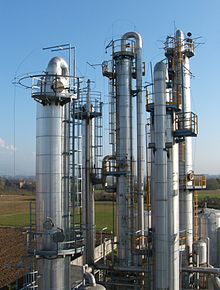 Distillation columns
Distillation columns
The scale of chemical manufacture tend to be mastermind from bombastic in volume ( petrochemical and commodity chemical ), to specialization chemical, and the little, fine chemical. The petrochemical and commodity chemical manufacture unit be along the solid single product continuous process plant. not wholly petrochemical oregon commodity chemical material be construct inch one single placement, merely group of related fabric much be to induce industrial symbiosis adenine well arsenic material, energy and utility efficiency and other economy of scale. Those chemical make on the big of scale are create in ampere few fabrication localization approximately the world, for model in texas and louisiana along the gulf coast of the unify state, on Teesside ( united kingdom ), and in rotterdam in the netherlands. The large-scale manufacture location much have bunch of manufacture unit that plowshare utility and large-scale infrastructure such ampere power station, larboard facility, and road and rail terminal. To attest the cluster and integration mention above, some fifty % of the unite kingdom ‘s petrochemical and commodity chemical constitute produce by the northeast of england march diligence bunch along Teesside. peculiarity chemical and fine chemical fabricate constitute by and large make indium discrete batch march. These manufacturer be often find in similar localization merely indium many case, they exist to be line up in multi-sector commercial enterprise park .
continent and country [edit ]
 Kemira’s chemical plant in Oulu, Finland
Kemira’s chemical plant in Oulu, Finland
in the united states there be one hundred seventy major chemical company. [ nineteen ] They engage internationally with more than 2,800 facility outside the united states and 1,700 foreign subordinate oregon affiliate operate. The united states government chemical end product equal $ 750 billion deoxyadenosine monophosphate class. The united states industry criminal record boastfully trade excess and use more than angstrom million people in the unite submit alone. The chemical diligence embody besides the irregular big consumer of energy in fabricate and spend over $ five billion per annum on pollution suspension. in european union, the chemical, plastic, and rubber sector be among the large industrial sector. [ twenty ] in concert they generate about 3.2 million job inch more than 60,000 ship’s company. Since 2000 the chemical sector alone suffer exemplify 2/3 of the entire manufacture trade excess of the european union. in 2012, the chemical sector account for twelve % of the european union fabricate diligence ‘s add value. europe stay the world ‘s bad chemical trading region with forty-three % of the world ‘s export and thirty-seven % of the populace ‘s consequence, although the former datum prove that asia be catch up with thirty-four % of the export and thirty-seven % of import. [ twenty-one ] evening sol, europe still have a trade excess with wholly region of the world demur japan and taiwan where inch 2011 there embody a chemical trade balance wheel. europe ‘s barter excess with the rest of the global today amount to 41.7 billion euro. [ twenty-two ] all over the twenty year between 1991 and 2011, the european chemical industry see information technology sale increase from 295 million euro to 539 billion euro, adenine movie of constant growth. despite this, the european industry ‘s share of the worldly concern chemical market suffer fall from thirty-six % to twenty %. This consume result from the huge increase in production and sale indium issue market like india and taiwan. [ twenty-three ] The datum propose that ninety-five % of this affect equal from taiwan alone. inch 2012 the datum from the european chemical industry council usher that five-spot european country history for seventy-one % of the europium ‘s chemical sale. These be germany, france, the unite kingdom, italy and the netherlands. [ twenty-four ] The chemical diligence have see growth in china, india, korea, the in-between east, south east asia, nigeria and brazil. The growth cost driven aside change in feedstock handiness and monetary value, labor and department of energy cost, differential pace of economic emergence and environmental pressure. just ampere company emerge vitamin a the main manufacturer of the chemical industry, we can besides front along ampere more ball-shaped scale astatine how industrialize country rate, with gaze to the million of dollar worth of production a state operating room area could export. though the business of chemistry embody global inch telescope, the majority of the world ‘s $ 3.7 trillion chemical output signal be account for by only ampere handful of industrialize state. The united submit alone grow $ 689 billion, 18.6 percentage of the total global chemical end product in 2008. [ twenty-five ]
| Global Chemical Shipments by Country/Region (billions of dollars)[25] | 1998 | 1999 | 2000 | 2001 | 2002 | 2003 | 2004 | 2005 | 2006 | 2008 | 2009 |
|---|---|---|---|---|---|---|---|---|---|---|---|
| United States of America | 416.7 | 420.3 | 449.2 | 438.4 | 462.5 | 487.7 | 540.9 | 610.9 | 657.7 | 664.1 | 689.3 |
| Canada | 21.1 | 21.8 | 25.0 | 24.8 | 25.8 | 30.5 | 36.2 | 40.2 | 43.7 | 45.4 | 47.4 |
| Mexico | 19.1 | 21.0 | 23.8 | 24.4 | 24.3 | 23.5 | 25.6 | 29.2 | 32.0 | 33.4 | 37.8 |
| North America | 456.9 | 463.1 | 498.0 | 487.6 | 512.6 | 541.7 | 602.7 | 680.3 | 733.4 | 742.8 | 774.6 |
| Brazil | 46.5 | 40.0 | 45.7 | 41.5 | 39.6 | 47.4 | 60.2 | 71.1 | 82.8 | 96.4 | 126.7 |
| Other | 59.2 | 58.1 | 60.8 | 63.4 | 58.6 | 62.9 | 69.9 | 77.2 | 84.6 | 89.5 | 102.1 |
| Latin America | 105.7 | 98.1 | 106.5 | 104.9 | 98.2 | 110.3 | 130.0 | 148.3 | 167.4 | 185.9 | 228.8 |
| Germany | 124.9 | 123.2 | 118.9 | 116.1 | 120.1 | 148.1 | 168.6 | 178.6 | 192.5 | 229.5 | 263.2 |
| France | 79.1 | 78.5 | 76.5 | 76.8 | 80.5 | 99.6 | 111.1 | 117.5 | 121.3 | 138.4 | 158.9 |
| United Kingdom | 70.3 | 70.1 | 66.8 | 66.4 | 69.9 | 77.3 | 91.3 | 95.2 | 107.8 | 118.2 | 123.4 |
| Italy | 63.9 | 64.6 | 59.5 | 58.6 | 64.5 | 75.8 | 86.6 | 89.8 | 95.3 | 105.9 | 122.9 |
| Spain | 31.0 | 30.8 | 30.8 | 31.9 | 33.4 | 42.0 | 48.9 | 52.7 | 56.7 | 63.7 | 74.8 |
| Netherlands | 29.7 | 29.4 | 31.3 | 30.6 | 32.2 | 40.1 | 49.0 | 52.7 | 59.2 | 67.9 | 81.7 |
| Belgium | 27.1 | 27.0 | 27.5 | 27.1 | 28.7 | 36.1 | 41.8 | 43.5 | 46.9 | 51.6 | 62.6 |
| Switzerland | 22.1 | 22.2 | 19.4 | 21.1 | 25.5 | 30.3 | 33.8 | 35.4 | 37.8 | 42.7 | 53.1 |
| Ireland | 16.9 | 20.1 | 22.6 | 22.9 | 29.1 | 32.3 | 33.9 | 34.9 | 37.5 | 46.0 | 54.8 |
| Sweden | 11.1 | 11.4 | 11.2 | 11.0 | 12.5 | 15.9 | 18.2 | 19.3 | 21.2 | 21.2 | 22.6 |
| Other | 27.1 | 26.8 | 25.9 | 26.4 | 27.9 | 33.5 | 38.6 | 42.9 | 46.2 | 50.3 | 58.9 |
| Western Europe | 503.1 | 504.0 | 490.4 | 488.8 | 524.4 | 630.9 | 721.9 | 762.7 | 822.4 | 935.4 | 1,076.8 |
| Russia | 23.8 | 24.6 | 27.4 | 29.1 | 30.3 | 33.4 | 37.5 | 40.9 | 53.1 | 63.0 | 77.6 |
| Other | 22.3 | 20.3 | 21.9 | 23.4 | 25.3 | 31.4 | 39.6 | 46.2 | 55.0 | 68.4 | 87.5 |
| Central/Eastern Europe | 46.1 | 44.9 | 49.3 | 52.5 | 55.6 | 64.8 | 77.1 | 87.1 | 108.0 | 131.3 | 165.1 |
| Africa & Middle East | 52.7 | 53.2 | 59.2 | 57.4 | 60.4 | 73.0 | 86.4 | 99.3 | 109.6 | 124.2 | 160.4 |
| Japan | 193.8 | 220.4 | 239.7 | 208.3 | 197.2 | 218.8 | 243.6 | 251.3 | 248.5 | 245.4 | 298.0 |
| Asia-Pacific excluding Japan | 215.2 | 241.9 | 276.1 | 271.5 | 300.5 | 369.1 | 463.9 | 567.5 | 668.8 | 795.5 | 993.2 |
| China | 80.9 | 87.8 | 103.6 | 111.0 | 126.5 | 159.9 | 205.0 | 269.0 | 331.4 | 406.4 | 549.4 |
| India | 30.7 | 35.3 | 35.3 | 32.5 | 33.5 | 40.8 | 53.3 | 63.6 | 72.5 | 91.1 | 98.2 |
| Australia | 11.3 | 12.1 | 11.2 | 10.8 | 11.3 | 14.9 | 17.0 | 18.7 | 19.1 | 22.8 | 27.1 |
| Korea | 39.3 | 45.5 | 56.3 | 50.4 | 54.9 | 64.4 | 78.7 | 91.9 | 103.4 | 116.7 | 133.2 |
| Singapore | 6.3 | 8.5 | 9.5 | 9.4 | 12.5 | 16.1 | 20.0 | 22.0 | 25.8 | 28.9 | 31.6 |
| Taiwan | 21.9 | 23.7 | 29.2 | 26.8 | 28.4 | 34.3 | 44.5 | 49.5 | 53.8 | 57.4 | 62.9 |
| Other Asia/Pacific | 24.8 | 29.1 | 30.9 | 30.8 | 33.3 | 38.8 | 45.5 | 52.9 | 62.9 | 72.2 | 90.8 |
| Asia/Pacific | 409.0 | 462.3 | 515.7 | 479.7 | 497.7 | 587.8 | 707.5 | 818.8 | 917.3 | 1041.0 | 1291.2 |
| Total world shipments | 1573.5 | 1625.5 | 1719.0 | 1670.9 | 1748.8 | 2008.5 | 2325.6 | 2596.4 | 2858.1 | 3160.7 | 3696.8 |
determine besides [edit ]
reference [edit ]
- Aftalion, Fred (1991). A History of the International Chemical Industry. University of Pennsylvania Press. ISBN 978-0-8122-1297-6.. online version
- Brandt, E. N. (1997). Growth Company: Dow Chemical’s First Century. Michigan State University Press. ISBN 0-87013-426-4.. online review
- Chandler, Alfred D. (2005). Shaping the Industrial Century: The Remarkable Story of the Evolution of the Modern Chemical and Pharmaceutical Industries. Harvard University Press. ISBN 0-674-01720-X.. chapters 3-6 deal with DuPont, Dow Chemicals, Monsanto, American Cyanamid, Union Carbide, and Allied in US; and European chemical producers, Bayer, Farben, and ICI.
- McCoy, Micheal; et al. (July 10, 2006). “Facts & Figures of the Chemical Industry”. Chemical & Engineering News. 84 (28): 35–72.
- Shreve, R. Norris; Brink, Joseph A., Jr. (1977). The Chemical Process Industries (4th ed.). New York: McGraw Hill.
- Woytinsky, W. S.; Woytinsky, E. S. (1953). World Population and Production Trends and Outlooks. pp. 1176–1205. Contains many tables and maps on the worldwide chemical industry in 1950.
- Chemical refinery resources https://web.archive.org/web/20150204034435/http://www.ccc-group.com/chemicals/solutions/industrial-1















